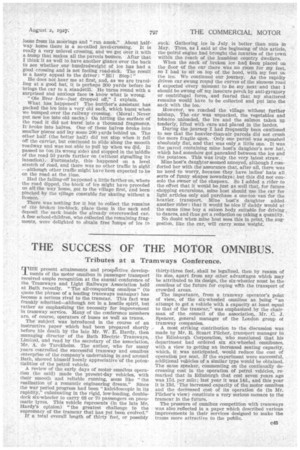THE SUCCESS OF THE MOTOR OMNIBUS.
Page 65

If you've noticed an error in this article please click here to report it so we can fix it.
Tributes at a Tramways Conference.
T"present attainments and prosactive developments of the motor omnibus in passenger transport received ample recognition at the annual conference of the Tramways and Light Railways Association held at Bath recently. "The all-conquering omnibus" (to quote the phrase of a leading tramways manager) has become a serious rival to the tramcar. This fact was frankly admitted—although not in a hostile spirit, but rather as emphasizing the necessity for improvement in tramway service. Many of the conference members are, of course, operators of buses as well as trams.
The subject was introduced in the course of an instructive paper which had been prepared shortly before his death by the late Mr. W. E. Hardy, then managing director of the Bath Electric Tramways, Limited, and read by the secretary of the association, Mr. A. de Turckheim. The author, who for many years controlled the successful tramway and omnibus enterprise of the company's undertaking in and around Bath, showed himself keenly appreciative of the potentialities of the petrol vehicle.
A review of the early days of motor omnibus operation (he said) made the present-day vehicles, with their smooth and reliable running, seem like "the realization of a romantic engineering dream." Since the war period progress had been "kaleidoscopic in its rapidity," culminating in the rigid, low-loading, doubledeck six-wheeler to carry 68 or 70 passengers on pneuinatic tyres. This vehicle represents (in the late Mr. Hardy's opinion) "the greatest challenge to the supremacy of the tramcar that has yet been evolved." If a total overall length of thirty feet, or possibly thirty-three feet, shall be legalized, then by reason of its size, apart from any other advantages which may be attributed to its design, the six-wheeler must be the omnibus of the future for coping with the transport of crowded areas.
The importance, from a tramway operator's point of view, of the six-wheeled omnibus as being "an attempt to get a vehicle with a capacity at least equal to that of the tramcar," was emphasized by the chairman of the council of the association, Mr. C. J. Spencer, general manager of the London group of tramway companies.
A most striking contribution to the discussion was made by Mr. R. Stuart Pilcher, transport manager to the Edinburgh Corporation, who mentioned that his department had ordered six six-wheeled omnibuses, with a view to getting an increased seating capacity, which, it was anticipated, would reduce the cost of operation per seat. If the experiment were successful, additional vehicles of a similar type would be obtained. The same speaker, commenting on the continually decreasing cost in the operation of petrol vehicles, remarked that in Edinburgh that cost seven years ago was 17d. per mile; last year it was 14d., and this year it is 13d. The increased capacity of the motor omnibus and the decreased cost of its operation do (in Mr. Pilcher's view) constitute a very serious menace to the tramcar in the future.
The pressure of omnibus competition with tramways was also reflected in a paper which described various improvements in their services designed to make the trains more attractive to the public.












































































































